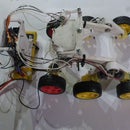Introduction: Waste Oil Burner
I've been blacksmithing in my backyard on and off for a little over a year now. I've had no success with propane and charcoal doesn't really get hot enough. My forge itself is little more than a pile of bricks. After a while I decided I wanted to try casting aluminum and for that I needed more heat. Thus, I built my waste oil burner. This version of waste oil burner functions by vaporizing oil on contact with the hot steel. It's built primarily of plates of steel. it's a box shape because boxes are easier to weld. The only important thing is that there be some sort of chamber and a vent into which air might be blown. It doesn't have to be airtight or match specific dimensions. You could make it in a weekend if you were really driven. Quick, easy, but difficult to light. I've mostly provided pictures as written instructions aren't particularly helpful for this. Feel free to ask questions and/or post suggestions in the comments.
Step 1: Stuff
All right so this is what you need. Notice, the parts are fairly vague because I just made it with whatever I had laying around.
- 1/4 inch steel (vents)
- 1/2 inch steel (body)
- 1/4 copper tubing
- 1/4 inch needle valve (or something capable of regulating the oil flow)
- Oil, and something in which to hold it
- furnace blower, my design uses a blower with out dimensions of 3" by 2.5" but you could get by with anything from a vacuum cleaner to a squirrel cage blower if you had to, but of course the dimensions would have to be modified
- Hose Clamps
Tools
- Oxyacetylene Torch equipped to cut steel, or another form of gas powered cutting device
- Angle Grinder, useful for touching up any mistakes and/or as an alternative to a torch (but that would take way longer)
- Hacksaw, if you really feel the need to make this but don't have any of the above tools (about the equivalent of replacing an airplane engine with a hand crank)
- Drill and Bits, 1/4 inch or whatever fits your oil line
- Welder, arc, gas, whatever, take your pick (I used an arc welder)
- Bench Grinder (when you realize that you suck at cutting steel and really have to clean up your cuts)
- Burn Cream/Bandages (you'll thank me later)
- Eye Protection, shades, safety glasses, welding mask, face protector
- Screwdriver
- Wrench
- Whatever I Forgot to Mention Or You End Up Needing Anyway
Step 2: Cut the Steel
I've included the sketchup version of my design and the stl file version. It's too scale so it shouldn't be too hard to figure out. It's basically a box with some holes in it so it's about as simple as it gets. Its dimensions correspond with the size of my blower, you may have to change the dimensions too fit yours. Cut the steel apart. It doesn't have to be perfect but you can clean up the edges with whatever grinder you happen to have. Remember that the whole thing is probably going to be covered in oil or on fire at some point so accuracy and aesthetics don't matter much. At some point you'll probably think it's a good idea to pick up hot metal, don't. Admittedly, I could warn you all I wanted and you would still probably do it (I certainly did). Something about hot metal just begs to be picked up. Maybe it's the addled state I was in after inhaling burning metal and paint fumes but I just had to touch it. Anyway. Pyrophilia aside, melting through metal really is fun and fairly straightforward so I won't bother you with details much. Holes for the ducts will have to be cut at some point to so probably don't weld everything together before doing that.
Step 3: Weld
Fire up your welder and start sticking stuff together. I'd suggest putting the ducts together first so that you can fit them to the base and cut the holes for them. Tac the pieces together then weld a solid bead along every joint. Make sure your joints are solid because they're going to have to hold up to some fairly strong forces. It doesn't have to be airtight but any major gaps are going to let flame out. Follow the pictures (but don't look at them too closely, I'm a terrible welder). Weld the ducts first and then cut out the vent holes to fit them.
Step 4: FIRE IT UP! (and Last Details)
Drill the hole for the fuel line. This should be after the air gate but far enough from the fire that the tubing won't melt. Should be drilled in the air duct. You'll need an air gate unless you've got a rheostat attached to your blower. You'll also need to put a bend in a short piece of copper pipe attached to the needle valve. Start the fire by stuffing the blower full of newspaper or oil soaked rags. Start with low air and no oil. Once the burner gets hot start adding oil and air. This isn't easy to get right and is mostly trial and error.
Step 5: Air Gate
Most blowers even remotely suited to running forges/foundries are air cooled or have to be run at full power for electrical reasons. This basically means that you can't just connect a rheostat or stick something over the blower opening to restrict the airflow. This leaves us with the need to cover the fan output somehow in an adjustable way. This isn't too hard to make. Just cut a slot in either side of the vent and cut a bar of metal to slide across the opening. Notch one end so that you can adjust the airflow to some extent. this can be done with a torch but you will need to grind the edges or the gate will never slide. You really have to do this after you have made the vent because you never know how the vent will turn out. Mine was off by almost a quarter inch but it still works fine. The important thing is to not expect the gate to fit if you cut it out before assembling the vent.















